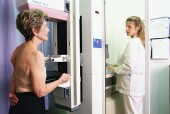Mammograms Might Spot Stroke Risk
Calcifications in breast arteries upped chances of cardiovascular trouble, study finds.
By Kathleen Doheny
HealthDay Reporter
|
E-mail this article
Subscribe to news
Printer friendly version
|

(SOURCES: Suzanne Steinbaum, D.O., director, Women and Heart Disease, Heart and Vascular Institute, Lenox Hill Hospital, New York City; Paul S. Dale, M.D., chief, surgical oncology, University of Missouri Ellis Fischel Cancer Center, Columbia; Feb. 20, 2008, presentation, International Stroke Conference, New Orleans)
WEDNESDAY, Feb. 20 (HealthDay News) -- In addition to detecting breast cancer in its early stages, new research suggests that mammograms may also help predict which women are at risk for strokes.
Calcifications found in the blood vessels of the breasts -- what doctors call benign arterial calcifications -- were more commonly found on the mammograms of women who had suffered a stroke, said Dr. Paul S. Dale, chief of surgical oncology at the University of Missouri's Ellis Fischel Cancer Center. He is the lead author of the research, which was expected to be presented Wednesday at the American Stroke Association's International Stroke Conference in New Orleans.
Previous studies, including some by the University of Missouri team, have found a link between these calcifications, which are not cancerous, and the risk of diabetes, heart disease and stroke. But Dale said he believes this latest study has found an even stronger association.
In all, they looked at 793 mammograms of women aged 40 to 90. On the screening mammograms, 86 of the 793 women, or about 10 percent, had the calcifications. But 115 of the 204 women in the group who had had stroke had the calcifications.
"Of those who had a stroke, 56 percent of them had these calcifications on their mammogram, compared to about 10 percent of women in the general population," Paul said. "The important thing here is, we adjusted for age, because age increases your risk of stroke and also of having calcifications on your mammogram."
While the finding is not brand new, it is interesting, said Dr. Suzanne Steinbaum, director of Women and Heart Disease at the Heart and Vascular Institute at Lenox Hill Hospital in New York City. "There have been other studies to show this," she said. "As a cardiologist, I would love this information."
It's one more piece of information, she said, that could potentially help inform doctors about a woman's risk for cardiovascular disease.
If she got a mammogram from a patient with that information, she said, "it would lead me to believe I need to screen this woman for cardiovascular disease."
Dale's team is continuing to study the link between the calcifications and cardiovascular diseases and diabetes. It's probably too soon, he said, to advise women to ask their doctor if they have calcifications on the mammogram. After more research is done, that might be a consumer-savvy step.
Stroke is the third leading cause of death for women over 40, Dale noted.
More information
To learn more about stroke, visit American Stroke Association. 
Copyright © 2008 ScoutNews, LLC. All rights reserved. 
HealthDayNews articles are derived from various sources and do not reflect federal policy. healthfinder.gov does not endorse opinions, products, or services that may appear in news stories. For more information on health topics in the news, visit the healthfinder.gov health library.